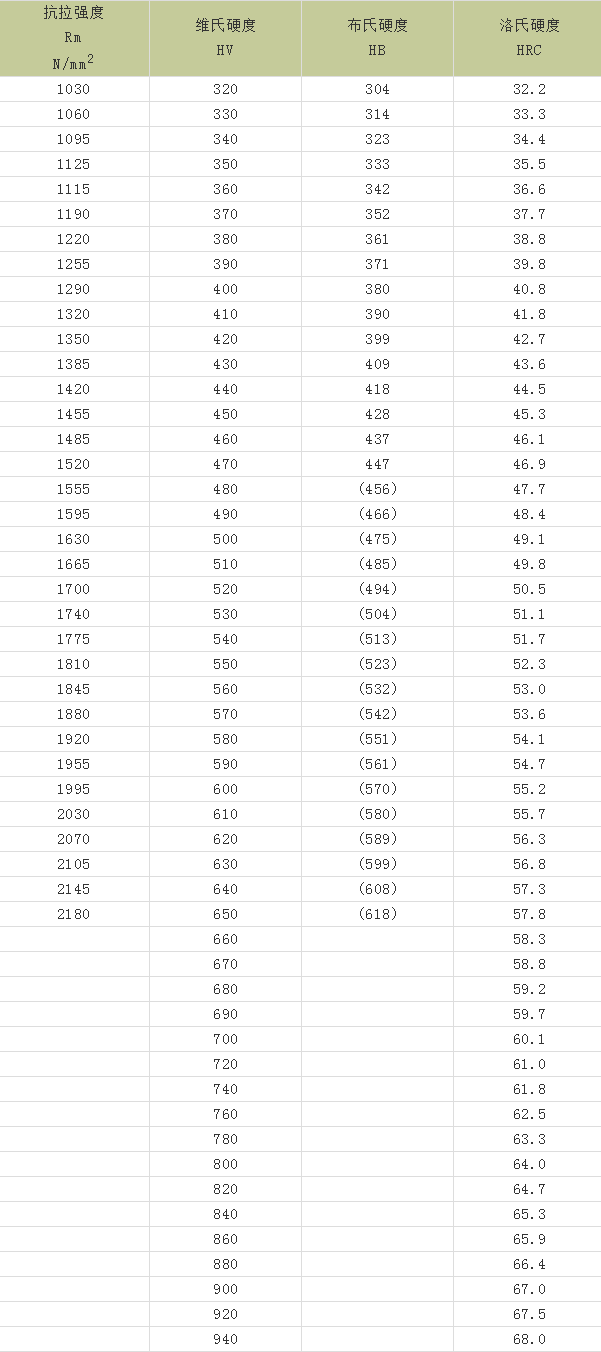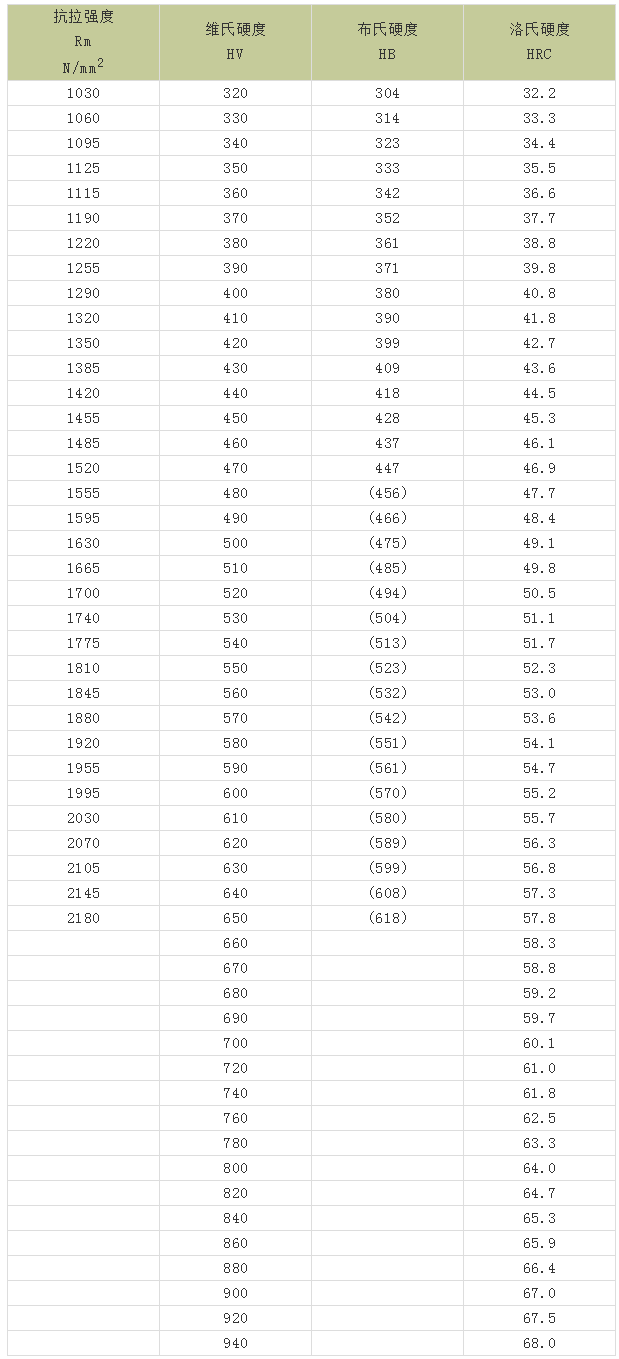1 hardness introduction
Hardness indicates the ability of a material to resist the pressing of a hard object into its surface. It is one of the important performance indicators of metallic materials. Generally, the higher the hardness, the better the wear resistance. Commonly used hardness indexes are Brinell hardness, Rockwell hardness and Vickers hardness.
Brinell hardness (HB)
A certain size (usually 3000kg) of a hardened steel ball of a certain size (typically 10mm in diameter) is pressed into the surface of the material for a period of time. After the load is removed, the ratio of the load to the area of ​​the indentation is the Brinell hardness value ( HB), the unit is kg/mm2 (N/mm2).
Rockwell hardness (HR)
When HB>450 or the sample is too small, the Brinell hardness test cannot be used instead of the Rockwell hardness measurement. It uses a diamond cone with a apex angle of 120° or a steel ball with a diameter of 1.59 and 3.18 mm, and is pressed into the surface of the material to be tested under a certain load, and the hardness of the material is determined from the depth of the indentation. According to the hardness of the test material, it is represented by three different scales:
• HRA: is a hardness obtained with a 60kg load and a diamond cone indenter for materials with extremely high hardness (such as cemented carbide).
• HRB: is a hardened steel ball with a load of 100kg and a diameter of 1.58mm. The hardness is used for materials with lower hardness (such as annealed steel, cast iron, etc.).
• HRC: is the hardness obtained with a 150kg load and a diamond cone indenter for materials with high hardness (such as hardened steel).
Vickers hardness (HV)
Pressing the surface of the material with a load of 120 kg or less and a diamond square cone presser with a apex angle of 136°, the surface area of ​​the material indentation pit is divided by the load value, which is the Vickers hardness HV value (kgf/mm2).
Note: A, B, and C in HRA, HRB, HRC, etc. in Rockwell hardness are three different standards, called scale A, scale B, and scale C. The Rockwell hardness test is one of several common indentation hardness tests used today. The initial pressure of all three scales is 98.07N (10kgf), and the hardness value is calculated according to the indentation depth. The ruler A uses a ball cone diamond indenter and is then pressurized to 588.4 N (60 kgf); the ruler B uses a steel ball with a diameter of 1.588 mm (1/16 inch) as the indenter, and then pressurizes to 980.7 N. (100kgf); while the scale C uses the same cone diamond as the scale A as the indenter, but the force after pressurization is 1471N (150kgf). Therefore, scale B is suitable for relatively soft materials, while scale C is suitable for harder materials. Practice has proved that there is an approximate relationship between the hardness values ​​and the strength values ​​of various hardness values ​​of metal materials. Since the hardness value is determined by the initial plastic deformation resistance and the continued plastic deformation resistance, the higher the strength of the material, the higher the plastic deformation resistance and the higher the hardness value. However, the conversion relationship of various materials is not consistent.
2 hardness comparison table
According to the German standard DIN50150, the following is a comparison table of tensile strength and Vickers hardness, Brinell hardness and Rockwell hardness of the steel range in the usual range.


The hardness test is the simplest and most convenient test method in the mechanical properties test. In order to be able to replace some mechanical properties tests with hardness tests, a relatively accurate conversion relationship between hardness and strength is required for production. Practice has proved that there is an approximate relationship between the hardness values ​​and the strength values ​​of various hardness values ​​of metal materials. Since the hardness value is determined by the initial plastic deformation resistance and the continued plastic deformation resistance, the higher the strength of the material, the higher the plastic deformation resistance and the higher the hardness value.
3 hardness conversion formula
1. Shore hardness (HS) = Boer hardness (BHN)/10+12
2. Shore hardness (HS) = Rockwell hardness (HRC) + 15
3. Boer Hardness (BHN) = Rockwell Hardness (HV)
4. Rockwell hardness (HRC) = Boer hardness (BHN)/10-3
Hardness measurement range:
HS<100
HB<500
HRC<70
HV<1300
The following are some of the domestic research results on hardness conversion.
1. Conversion of Knoop hardness and Vickers hardness
(1) Based on the same hardness, the two indenters of Knoop's Vickers have equal resistance, and the stresses of the two indenters of Vickers Knoop under load are deduced respectively, and then according to σHK=σHV :HV=0.968HK. This formula is measured under low load and the error is relatively large. In addition, when the hardness value is greater than HV900, this formula has a large error and loses the reference value.
(2) After the derivation and correction, the conversion formula of Knoop hardness and Vickers hardness is

According to the actual data, the maximum relative conversion error of the formula is 0.75%, which has a high reference value.
2. Conversion of Rockwell hardness and Vickers hardness
(1) The Qvarnstorm conversion formula proposed by Hans·Qvarnstorm

After the correction, the conversion formula of Rockwell hardness and Vickers hardness is obtained as follows:

This formula is scaled by the ferrous metal hardness standard data published in China. The HRC error is basically within the range of ±0.4 HRC, and the maximum error is only 0.9HRC. The calculated HV error is ±15HV.
(2) According to the stress σHRC=σHV of different indenters, the formula is obtained by analyzing the curve of Rockwell hardness and Vickers hardness indentation depth.

This formula is compared with the national standard experimental conversion value, and the error between the conversion formula and the standard experimental value is ±0.1HRC.
(3) According to the actual experimental data, the linear regression method is used to study the conversion of Rockwell hardness and Vickers hardness, and the formula is obtained:

This formula has a small range of use and large error, but it is easy to calculate and can be used when the accuracy is not high.
3. Conversion of Rockwell hardness and Brinell hardness
(1) Analysis of the relationship between Brinell indentation and Rockwell indentation depth, according to the stress of the indenter σHRC
=σHB to get the conversion formula

The calculated results are compared with the national standard experimental values, and the error between the conversion formula and the standard experimental value is ±0.1HRC.
(2) Get the formula by linear regression method based on actual experimental data

The formula error is too large, the use range is small, but the calculation is simple, and can be used when the accuracy is not high.
4. Conversion of Brinell hardness and Vickers hardness
The relationship between Brinell hardness and Vickers hardness is also calculated according to σHB=σHV. The conversion result of this formula is compared with the national standard conversion value, and the conversion error is ±2HV.

5. Conversion of Knoop hardness and Rockwell hardness
Because the corresponding curve of Knoop hardness and Rockwell hardness is similar to parabola [7], the approximate conversion formula derived from the curve is

This formula is more accurate and can be used as a reference.

a) The values ​​indicated in bold in this table are consistent with the hardness conversion values ​​in accordance with ASTM-E140 Table 1, from the corresponding SAE-ASM-ASTM
Listed by the Federation.
b) The values ​​in parentheses are out of range and are for reference only.
Directly convert the Rockwell hardness of the workpiece using the Brinell hardness indentation diameter
At the production site, the hardness of large quenched parts is often measured using a Brinell hardness tester due to the limitations of the test equipment. If you want to know the Rockwell hardness value of the workpiece, the usual method is to measure the Brinell hardness value and then find the corresponding Rockwell hardness value according to the conversion table. This method is obviously cumbersome. Then, can you calculate the Rockwell hardness value of the workpiece directly based on the indentation diameter of the Brinell hardness tester? The answer is certainly yes. According to the Brinell hardness and Rockwell hardness conversion table, an empirical formula that is simple and easy to remember can be summarized: HRC = (479-100D)/4, where D is a Φ10mm steel ball indenter pressed against the workpiece at 30KN pressure. Indentation diameter measurement on. The error between the calculated value and the converted value is in the range of 0.5 to -1. This formula is very convenient to use in the field. You may wish to give it a try.
The 20V 2Ah 4Ah Cordless Plunge Cut Track Saw is Perfect for Cutting Wood, with High Precision, No burrs with good blade.
It is a Cordless wood cutting power tools that users feels much better, compared to Jig Saw or circular saw.
The Cordless Plunge Cut Saw with 30mm cutting depth without track.
The Cordless Plunge Track Saw With single speed, 4000rpm.
The 110mm Cordless Track Saw with Shaft Lock, for easy blade change.
Cordless Power Saw With a dust blower for max cut -line visibility.
Cordless Wood Cutting Power Tools with protection button for your safety, soft rubber handle for comfortable use.
The Cordless Tack Saw used with the Guide Rail or Track, to ensure the cutting straight ability for long distance work.
Plunge-Cut Circular Saw,Cordless Track Saw,Home Plunge Saw Cordless,Cordless Plunge Saws,Plunge Saws With Guide Rails
Ningbo Brace Power Tools Co., Ltd , https://www.cnbrace.com